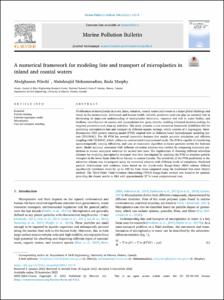| dc.contributor.author | Pilechi, Abolghasem | |
| dc.contributor.author | Mohammadian, Abdolmajid | |
| dc.contributor.author | Murphy, Enda | |
| dc.date.accessioned | 2023-05-20T14:32:50Z | |
| dc.date.available | 2023-05-20T14:32:50Z | |
| dc.date.issued | 2022 | |
| dc.identifier.citation | Pilechi, A., Mohammadian, A. and Murphy, E. (2022) A numerical framework for modeling fate and transport of microplastics in inland and coastal waters. Marine Pollution Bulletin, 184:114119, 15pp. DOI: https://doi.org/10.1016/j.marpolbul.2022.114119. | en_US |
| dc.identifier.uri | https://repository.oceanbestpractices.org/handle/11329/2228 | |
| dc.description.abstract | Proliferation of microplastics in rivers, lakes, estuaries, coastal waters and oceans is a major global challenge and
threat to the environment, livelihoods and human health. Reliable predictive tools can play an essential role in
developing an improved understanding of microplastics behaviour, exposure and risk in water bodies, and
facilitate identification of sources and accumulation hot spots, thereby enabling informed decision-making for
targeted prevention and clean-up activities. This study presents a new numerical framework (CaMPSim-3D) for
predicting microplastics fate and transport in different aquatic settings, which consists of a Lagrangian, three dimensional
(3D) particle-tracking model (PTM) coupled with an Eulerian-based hydrodynamic modeling system
(TELEMAC). The 3D PTM has several innovative features that enable accurate simulation and efficient
coupling with TELEMAC, which utilizes an unstructured computational mesh. The PTM is capable of considering
spatio-temporally varying diffusivity, and uses an innovative algorithm to locate particles within the Eulerian
mesh. Model accuracy associated with different advection schemes was verified by comparing numerical predictions
to known analytical solutions for several test cases. The implications of choosing different advection
schemes for modeling microplastics transport was then investigated by applying the PTM to simulate particle
transport in the lower Saint John River Estuary in eastern Canada. The sensitivity of the PTM predictions to the
advection scheme was investigated using six numerical schemes with different levels of complexity. Predicted
particle distributions and residence times based on the fourth-order Runge–Kutta (RK4) scheme differed
significantly (residence times by up to 100 %) from those computed using the traditional first-order (Euler)
method. The Third Order Total Variation Diminishing (TVD3) Runge-Kutta method was found to be optimal,
providing the closest results to RK4 with approximately 27 % lower computational cost. | en_US |
| dc.language.iso | en | en_US |
| dc.rights | Attribution-NonCommercial-NoDerivatives 4.0 International | * |
| dc.rights.uri | http://creativecommons.org/licenses/by-nc-nd/4.0/ | * |
| dc.subject.other | Particle tracking | en_US |
| dc.subject.other | Eulerian-Lagrangian model | en_US |
| dc.subject.other | Microplastics | en_US |
| dc.subject.other | Fate and transport modeling | en_US |
| dc.title | A numerical framework for modeling fate and transport of microplastics in inland and coastal waters. | en_US |
| dc.type | Journal Contribution | en_US |
| dc.description.refereed | Refereed | en_US |
| dc.format.pagerange | 15pp. | en_US |
| dc.identifier.doi | https://doi.org/10.1016/j.marpolbul.2022.114119 | |
| dc.subject.parameterDiscipline | Anthropogenic contamination | en_US |
| dc.subject.dmProcesses | Data analysis | en_US |
| dc.subject.dmProcesses | Data transformation/conversion | en_US |
| dc.bibliographicCitation.title | Marine Pollution Bulletin | en_US |
| dc.bibliographicCitation.volume | 182 | en_US |
| dc.bibliographicCitation.issue | Article 114119 | en_US |
| dc.description.sdg | 14.a | en_US |
| dc.description.maturitylevel | Mature | en_US |
| dc.description.adoption | Novel (no adoption outside originators) | en_US |
| dc.description.methodologyType | Method | en_US |
| obps.contact.contactname | Abolghasem Pilechi | |
| obps.contact.contactemail | Abolghasem.Pilechi@nrc-cnrc.gc.ca | |
| obps.resourceurl.publisher | https://www.sciencedirect.com/science/article/pii/S0025326X22008013?via%3Dihub | |
 Repository of community practices in Ocean Research, Applications and Data/Information Management
Repository of community practices in Ocean Research, Applications and Data/Information Management

